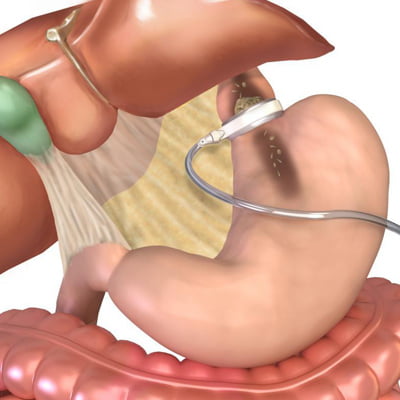What is Stomach Stapling?

Stomach stapling is a procedure to treat overweight patients when normal diet and exercise have not proven effective results. The procedure involves placing a clamp a few centimeters below where the stomach and esophagus join. By tightening this clamp, an anterior chamber is created above the stomach. As food is consumed, it falls into this small chamber which enables the patient to feel full and satisfied, and for a longer period of time.
The technique aims for less food intake as the fullness feeling is felt much quicker. Also known as Gastric Clamps, the clamps are made of silicone material, and contain no allergic effects. They are placed in the stomach laparoscopically and can provide an excessive amount of weight loss in about a year. The operation can be applied to patients with a body mass index of 40 and above. The operation takes an average of two hours

How Is Stomach Stapling Surgery Performed?
A Stomach stapling operation lasts approximately 2 hours. In the operation, a gastric clamp is placed in the patient’s body using a closed surgery method which ensures a comfortable process for both the patient and doctor. The operation is also performed under general anesthetic.
Before starting the operation, the patient’s abdominal area is hygienically cleaned. By doing this, the risk of postoperative complications are minimized. A small incision not exceeding 1 cm is made to reach the connection point between the esophagus and stomach.
Through the incisions, a gastric clamp is placed a few centimeters below the connecting point, between the stomach and esophagus. The inner wall of the inserted clamp is covered with a balloon-like structure. Approximately 1 month after the surgery, it is gradually inflated by injecting through the ports under the skin. The gastric clamp procedure also ensures that consumed food is digested slower. Thus, it becomes possible for patients to feel full for a longer time and the need for food is minimized. This procedure provides effective results when the diet specified by the doctor is followed.
How Is Stomach Stapling Surgery Performed?
A Stomach stapling operation lasts approximately 2 hours. In the operation, a gastric clamp is placed in the patient’s body using a closed surgery method which ensures a comfortable process for both the patient and doctor. The operation is also performed under general anesthetic.
Before starting the operation, the patient’s abdominal area is hygienically cleaned. By doing this, the risk of postoperative complications are minimized. A small incision not exceeding 1 cm is made to reach the connection point between the esophagus and stomach.
Through the incisions, a gastric clamp is placed a few centimeters below the connecting point, between the stomach and esophagus. The inner wall of the inserted clamp is covered with a balloon-like structure. Approximately 1 month after the surgery, it is gradually inflated by injecting through the ports under the skin.
The gastric clamp procedure also ensures that consumed food is digested slower. Thus, it becomes possible for patients to feel full for a longer time and the need for food is minimized. This procedure provides effective results when the diet specified by the doctor is followed.
Recovery Process of a Stomach Stapling Procedure
Hospital stay under observation after the operation is two days. Patients with diabetes, hypertension or heart disease may require longer time under observation.
Side effects such as vomiting, constipation and hair loss may occur in the first 6 months as the early postoperative period. If weight loss (monthly weight loss of 6 kg or more) occurs faster than expected, it can be a possibility of malnutrition, therefore a physician must be consulted if this occurs.
A special diet and exercise program is given to the patient after the operation. Patients should strictly follow this diet and avoid any harmful habits in order to achieve weight loss, prevent stomach problems and maintain a healthy diet.
Patients should not neglect the physical health checks in the first six months after the operation, and after the six months are over, a general examination should be undertaken every three months.
Advantages Of The Treatment
Gastric banding stands out as one of the most preferred for individuals with weight problems. The advantages of the surgery, which also helps to change eating habits and enter a healthier life, can be outlined as follows:
- Patients’ desire to eat decreases.
- It’s possible to achieve weight loss in the first few months after surgery.
- The risk of health problems due to excess weight are minimized.
- As it is a surgery applied with closed methods, the healing process is quite fast.
Stomach Stapling FAQs
What are the risk factors that can be seen in a stomach stapling surgery?
What are the risk factors that can be seen in a stomach stapling surgery?
The risks evaluated with a stomach stapling procedure are as follows:
Tightening of the clamp being more or less than normal.
Gastric clamp slipping out of its designated spot
Damage to tissues and organs during surgery
Stomach ulcer
Allergic reaction to silicone material
Risk of infection
Irritation at the point where the gastric band is worn
How does gastric banding help patients lose weight?
How does gastric banding help patients lose weight?
The small chamber formed at the point where the gastric clamp is inserted, is where the food consumed enters. The chamber being smaller than the normal stomach enables patients to feel full in a short period of time. Furthermore, patients feel satisfied for longer with less food as the food consumed gets digested in a longer period of time. Thus, allowing the weight loss process to be much faster.
How much should patients weigh for a stomach stapling surgery?
How much should patients weigh for a stomach stapling surgery?
For this weight loss operation patients must be between the ages of 18 and 60. In order for the surgery to give successful results, patients should be 40 to 50 kilograms more than their normal weight. The body mass index of the patient should be at least 40 to be able to undergo surgery.
When should the stomach staples be removed?
When should the stomach staples be removed?
As with other bariatric surgery options, stomach staples surgery allows patients to undergo a major change in the first year.
The full results of stomach staples surgery can be seen at the end of 24 months. After this period, and as long as the clamp does not damage the stomach, it can be removed at any time.
How long does a stomach staple surgery take?
How long does a stomach staple surgery take?
With the developing technology, a stomach staple operation is a very comfortable procedure and is performed under general anesthetic. This operation is a closed surgery, and can take an average of 2 hours.





